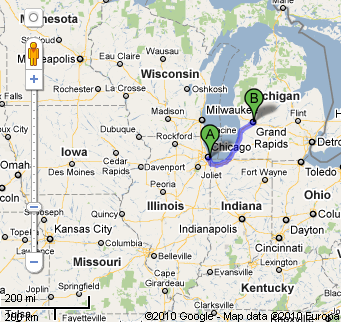When Joanne Branham lost her husband, Frank, to a brain tumor, she was devastated. But it wasn't until she visited her old neighbors in McCullom Lake, Illinois, that she began to question the cause of his death.
Back in the community where she and Frank had lived for almost 40 years, Branham learned two of her former neighbors also had brain tumors.
"It was like a light bulb went off," Branham recalls. "How can that many have cancer living right next door to each other?"
Since then, more brain cancer cases have turned up, 30 in all, among current and former residents of McCullom Lake, a community of about 1,000 residents in northern Illinois, not far from the Wisconsin state line.
Branham and others in McCullom Lake are now pointing the finger at a chemical plant a mile up the road in Ringwood, Illinois.
For decades, they say, the Rohm and Haas plant dumped, spilled and leaked thousands of pounds of vinyl chloride and other toxic chemicals, poisoning the water and air around McCullom Lake.
"I don't think there's been a bigger brain cancer cluster outside the workplace -- ever," says Aaron Freiwald, attorney for 31 McCullom Lake Village plaintiffs now suing Rohm and Haas. In addition to the brain cancer cases, there is one plaintiff alleging her liver damage resulted from environmental pollution. The company denies making anyone sick.
Branham's case is the first to go to trial, with jury selection set to begin Wednesday in Philadelphia, Pennsylvania.
Frank Branham died in June 2004, a month after learning that he had a deadly glioblastoma brain tumor. He was 63.
"Frank didn't have a chance," Joanne Branham says. "What they did was very wrong. They played with people's lives. I lost a husband, who was my best friend. The kids lost their father. The grandkids lost their grandfather," she added, barely able to get her words out through her tears.
Rohm and Haas says even though the cancer cases are close together, they are random.
"There is no cluster in McCullom Lake Village," says Kevin Van Wart, attorney for Rohm and Haas. "If you draw circles around selected cases, you can always draw the conclusion of something unusual."
Brain and central nervous system cancers strike 7.6 per 100,000 people in the United States, according to the National Cancer Institute. An estimated 22,020 men and women in the United States will get diagnosed with these cancers this year.
A month after the lawsuit was filed in 2006, the McHenry County Health Department in Illinois concluded there was no cluster of cancer cases in McCullom Lake. The U.S. Centers for Disease Control and Prevention did its own analysis and agreed.
The Rohm and Haas site produces polymers, adhesives, resins and sealants on a 120-acre site originally built as a dairy operation in 1916 and converted to chemical manufacturing in the early 1940s.
The facility has disposed its waste off site since 1978, but vinyl chloride, trichloroethylene, or TCE, and vinylidene chloride have all been found in nearby groundwater, according to the CDC.
The U.S. Department of Health and Human Services calls vinyl chloride "a known carcinogen." Long-term exposure to vinyl chloride on the job increases workers' risk of cancers of the liver, brain, lung and blood, according to the U.S. Agency for Toxic Substances and Disease Registry. ...
via What killed Frank Branham? - CNN.com.
This will be an interesting fight to watch. Polluters have more money and power. Vinyl chloride, trichloroethene and dichloroethylene may be the cause, but what about old fluoride leaks? This is the same general area where the world's first nuclear reactor was built (Point A on the map below). See the recent fluoride post. Point B is where the first fluoridation of water in the USA started, presumably using some of the waste fluoride from reactor fuel production.
In 1990 fluoride was found to be an equivocal carcinogen by the National Cancer Institute Toxicology Program. (Maurer, et. al.,"Fluoride an equivocal carcinogen. J.National Cancer Institute 82, 1118-26, 1990) In 1992 further studies by the New Jersey Department of Health confirmed a 6.9 fold increase in bone cancer in young males. (Cohn, Perry D. Ph.D. "An Epidemiological Report on Drinking Water" Fluoridation and Osteosarcoma in Young Males, New Jersey Department of Health, Environmental Health Service, Trenton NJ November 8, 1992) In 1997 there were more than 80 references available, linking fluoride to cancer. - link

1 comment:
There's been literally 100s of "cancer clusters" officially investigated since the 1950s/60s, or thereabouts. And, almost all have turned up clueless. They're usually said to be due to random clustering events. And, the statistics involved in such studies can be quite sophisticated. But, I wonder if it's only obscure the issue. There are, after all, some interest by outside parties about the result of the studies ... For example, I just read about a case in early 1980s of 6 leukemia cases in one school and 6 more in the neighborhood of the school, all of which occurred at about the same time. The CDC investigators, however, said that they doubted it would be anything more than random cluster, despite the fact that the event took place in the vicinity of several chemical mfg. that dealt with benzene, a well-known physiological trouble-maker. It might just be that politics plays a role in cancer cluster studies. Imagine that a political factor in a physiological disease!
Post a Comment